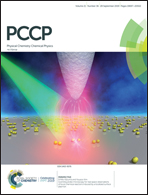Revealing working mechanisms of PFN as a cathode interlayer in conventional and inverted polymer solar cells†
Abstract
Energy level alignments at the PC71BM/PFN/Ag interface in conventional polymer solar cells (c-PSCs) and the ITO/PFN/PC71BM interface in inverted polymer solar cells (i-PSCs) are systematically investigated via ultraviolet photoelectron spectroscopy and by using the integer charge transfer (ICT) model. The findings demonstrate that PFN as a cathode interlayer is able to effectively reduce the electron extraction barriers from 0.72 eV to 0.38 eV for the c-PSCs and from 0.58 eV to 0.36 eV for the i-PSCs, respectively. In the c-PSCs, the final modified electron extraction barrier matches the predicted value (∼0.4 eV) using the ICT model. In the i-PSCs, there exists an intermixing layer of PFN and the active layer above PFN because some PFN is dissolved by the organic solvent in the active layer solution, resulting in a special energy level alignment at the PFN/PC71BM interface. ITO/PFN (2 nm)/PC71BM (20 nm) in the i-PSCs actually forms such an interface as ITO/PFN/PFN:PC71BM with an energy level alignment like Al/LiF/PC71BM/PFN (0.65 nm), which rationalizes a higher short circuit and fill factor in the i-PSCs than c-PSCs. Finally, a general model to simulate the intermixing layer between the organic cathode interlayer and the active layer has been proposed to describe the energy level alignment of the complicated interfaces in the i-PSCs.



 Please wait while we load your content...
Please wait while we load your content...